|
MACE, Asia’s Largest and World’s Highest Imaging Cherenkov Observatory, at Hanle, Ladakh
MACE project plays a significant role not only in advancing scientific research but also in supporting the socio-economic development of Ladakh.
- Major Atmospheric Cherenkov Experiment (MACE) Observatory MACE is the largest imaging Cherenkov telescope in Asia. Located at an altitude of ~4,300 m, it is also the highest of its kind in the world. The telescope is indigenously built by BARC with support from ECIL and other Indian industry partners. The inaugural of MACE Observatory was a part of the Platinum Jubilee year celebrations of the DAE.
It Is A Big Deal
- Major Atmospheric Cherenkov Experiment (MACE) is the highest of its kind in the world
- Asia’s largest imaging Cherenkov telescope, located at an altitude of almost 4,300 metres, was inaugurated on Wednesday at Ladakh’s Hanle.
- The Major Atmospheric Cherenkov Experiment (MACE) observatory, the highest of its kind of telescope in the world, has been indigenously built by the Mumbai-based Bhabha Atomic Research Centre (BARC) with support from the Electronics Corporation of India Ltd (ECIL) and other Indian industry partners.
- The MACE observatory is touted to place India at the forefront of cosmic ray research globally by allowing scientists to study high-energy gamma rays. This will pave the way for deeper understanding of the universe’s most energetic events, such as supernovae, black holes, and gamma-ray bursts.
- Even before its formal inauguration, the telescope produced high-quality work detecting gamma ray flares as far away as 200 million light years away.
MACE observatory
- MACE is 21 metres in diameter, 175 tonnes heavy, has reflector area of 356 sqm and 1,424 diamond-turned metallic mirror facets, 712 actuators, 1,088 photo-multiplier tubes, and 68 camera modules.
- It is a lightweight construction and features high strength and temperature endurance. Reflector surface measuring over 350 square metres (sqm) comprises highly reflective diamond-turned custom-built metallic mirror facets that are required to be aligned with an accuracy of 2 mm over parabolic surface. The camera at the focal point contains a number of photomultiplier tubes mounted with specialised assembly to enhance light collection efficiency.
- Ultrafast backend electronics with nanosecond digitization electronics is optimised for low-power and -temperature operations. Extreme weather conditions restrict transport to six-eight months a year and affect the availability of trained personnel on site.
- The MACE Telescope consists of a large-area tessellated light collector of 356 m², made up of 356 mirror panels. A high-resolution imaging camera weighing about 1200 kg, for detection and characterization of the atmospheric Cherenkov events, forms the focal plane instrumentation of the telescope. The elevation over azimuth mounted telescope basket structure has two axes movement capability of ± 270° in azimuth and -26° to +165° in elevation for pointing towards any source in the sky and tracking it. The telescope, which weighs about 180 tons, is supported on six wheels which move on a 27-metre-diameter track.
- The telescope has an integrated imaging camera, which contains 1088 photo multiplier-based pixels and all the signal processing and data acquisition electronics. The camera communicates the acquired data to the computer system in the control room over optical fiber.
How will the telescope work?
- Gamma rays do not reach the Earth’s surface as they are stopped by the atmosphere. However, interaction with the atmosphere creates high-energy particles that travel faster than the speed of flight and emit Cherenkov radiation which is akin to a sonic boom. The mirrors and cameras capture these flashes and trace them back to its cosmic source.
Why Hanle?
- The site has been carefully chosen for its unique scientific advantages as Hanle offers extremely low light pollution required for gamma ray observations. The longitudinal advantage of its location enables MACE to observe sources invisible to other parts of the world.
- “Hanle is like heaven for gamma ray astronomers with its dark skies, low humidity and almost no air pollution.
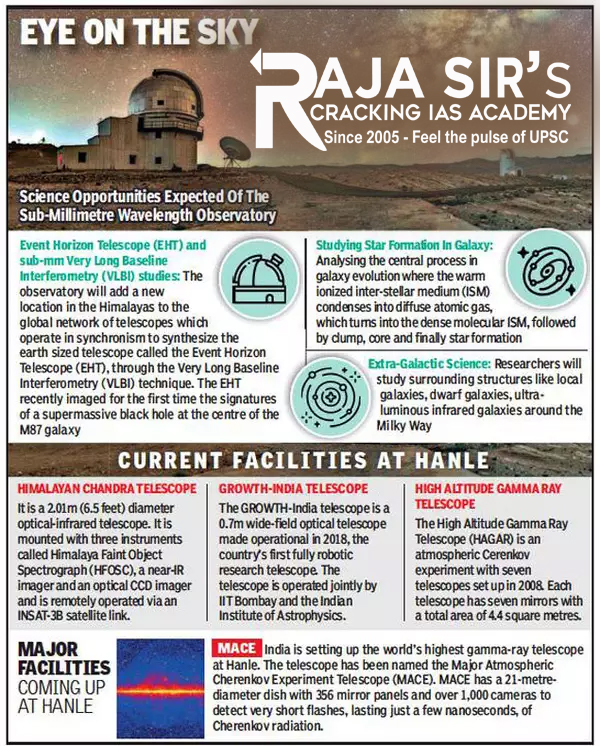
|
|
Doddalathur Megalithic Burial Site
A team of history and archaeology scholars from the University of Mysore have embarked on an excavation of megalithic burial sites in Chamarajanagar district, Karnataka.
Doddalathur Megalithic Burial Site
- Location: The megalithic site is located in a small valley formed by the Male Mahadeshwara Hill ranges.
- It dates back to the Megalithic-Iron Age (1200 BCE to 300 CE).
- The site features burials marked by large stone boulders in circular arrangements.
- Discovery: In 1961 by C Krishnamurti of the Archaeological Survey of India (ASI).
Current Excavation
- Objective:
- To explore megalithic-iron age culture in southern Karnataka.
- To gather scientific dating and cultural insights from the site.
- The department previously excavated the nearby habitation-cum-megalithic burial site of Budipadaga, 20 km from Doddalathur, in 2021 and 2022.
|
Aspect
|
Paleolithic
|
Mesolithic
|
Neolithic
|
|
Period
|
2.5 million years ago to 10,000 BCE
|
10,000 BCE to 8,000 BCE
|
8,000 BCE to 3,000 BCE
|
|
Habitat
|
Caves, temporary shelters, open plains
|
Semi-permanent camps near water sources
|
Permanent settlements, farming villages
|
|
Key Findings
|
Stone tools (e.g., hand axes), cave art, early fire usage
|
Microliths (small stone tools), bone tools, art (petroglyphs)
|
Agricultural tools, pottery, domesticated plants and animals
|
|
Lifestyle
|
Hunter-gatherers, nomadic lifestyle
|
Transition to more sedentary life, seasonal migration
|
Farming, animal husbandry, social stratification, trade
|
Megaliths
- A megalith is a large stone that has been used to construct a prehistoric structure or monument, either alone or together with other stones.
- They were constructed either as burial sites or commemorative (non-sepulchral) memorials.
- The megalithic monuments of peninsular India, believed to have been erected in the Iron Age (1500 BC – 200 AD).
- Origin: As megalithic societies were preliterate, the racial or ethnic origins of the megalithic people are thus difficult to pin down.
- Geographical Coverage: Though megalithic sites are found all across India, they are concentrated mostly in peninsular India.
Types of Megaliths
- Underground Components:
- Pit Burials: Unlined pits where one or more bodies are buried.
- Cist Burials: Stone-lined rectangular graves often used for burials.
- Urn Burials: Terracotta urns used to hold the mortal rem
- Sarcophagus Burials: Terracotta receptacles, often with lids, sometimes shaped like animals.
- Surface Components:
- Menhirs: Large, unshaped stones or minimally altered boulders, used as markers or memorials.
- Boulder Circles: Circular arrangements of rocks or boulders, marking burial sites.
- Cairns: Mounds of earth, often covering burials or other structures.
- Dolmenoid Cists: Partially underground stone structures with a capstone.
- Dolmens: Freestanding stone structures with a large capstone placed on upright stones.
- These elements form an important part of ancient burial practices and memorial structures found in various archaeological sites worldwide.
Some of the significant Megalithic Burial sites are mentioned in the following table.
|
State
|
Burial Sites
|
Features/Components Found
|
|
Jharkhand
|
Seraikela
|
Megalithic burials, large stone structures, urn burials, associated with iron age tools and artifacts.
|
|
Uttarakhand
|
Deodhoora (Almora district)
|
Early human habitation, rock shelters, and megalithic burial remains.
|
|
Uttar Pradesh
|
Koldihwa (Belan Valley), Banda, Mirzapur, Prayagraj, Varanasi
|
Chalcolithic materials, evidence of early agricultural practices, copper tools, and pottery.
|
|
Kerala
|
Thrissur, Kunnattur
|
Megalithic burial sites with Topikal, urn burials, stone circles, dolmens, and pottery artefacts.
|
|
Kashmir
|
Waztal, Burzahom, Brah
|
Burzahom: Pit dwellings, Neolithic to Megalithic transition, animal bones, tools, and ceramics.
|
|
Karnataka
|
Maski, Hallur, Chandravalli, Hire Benakal, Coorg, Heggadehalli, Brahmagiri
|
Megalithic dolmens, cist burials, iron tools, pottery, skeletal remains, evidence of early agriculture.
|
|
Andhra Pradesh
|
Nagarjunakonda
|
Buddhist relics, stupa remains, Megalithic burials, urn burials, stone tools, and pottery.
|
|
Maharashtra
|
Junapani, Khapa, Mahurjhari, Naikund (near Nagpur), Pune
|
Megalithic burials, stone circles, urn burials, copper and iron tools, skeletal remains, pottery, and beads.
|
|
Tamil Nadu
|
Adichanallur, Sanur, Kodumanal, Perumbair
|
Urn burials, iron implements, pottery, skeletal remains, and evidence of trade with ancient civilizations.
|
|
|
WHO declares that India has eliminated Trachoma as a public health problem in 2024
India becomes the third country in the South-East Asia Region to achieve this milestone
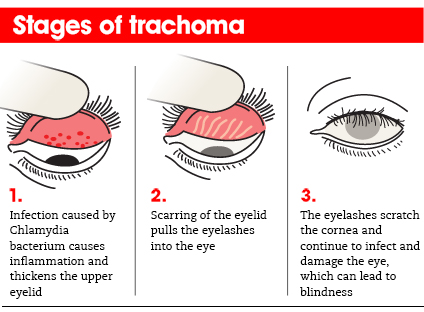
- Trachoma is a bacterial infection that affects the eyes. It is caused by the bacterium Chlamydia Trachomatis. Trachoma is contagious, spreading through contact with the eyes, eyelids, nose or throat secretions of infected people, if left untreated it causes irreversible blindness.
- WHO has termed Trachoma as a neglected tropical disease. WHO estimates suggest that 150 million people worldwide are affected by Trachoma and 6 million of them are blind or at risk of visually disabling complications. Trachoma is found in underprivileged communities living in poor environmental conditions.
- Trachoma was amongst the leading cause of blindness in the country during 1950-60. The Government of India launched the National Trachoma Control Program in 1963 and later on Trachoma control efforts were integrated into India’s National Program for Control of Blindness (NPCB).
- In 1971, blindness due to Trachoma was 5% and today, owing to the various interventions under the National Programme for Control of Blindness & Visual Impairment (NPCBVI), it has come down to less than 1%.
- WHO SAFE strategy was implemented throughout the country wherein SAFE stands for adoption of surgery, antibiotics, facial hygiene, environmental cleanliness etc. As a result, in 2017, India was declared free from infective Trachoma.
- The National Trachomatous Trichiasis (TT only) Survey was also carried out in 200 endemic districts of the country under NPCBVI from 2021-24, which was a mandate set by WHO in order to declare that India has eliminated Trachoma as a public health problem.
|
|
High Court Allocates ₹974 Crore for Rare Diseases, Forms National Committee.
The Delhi High Court directed the Union Government to establish the National Fund for Rare Diseases (NFRD).
- The Court also directed to allocate a sum of Rs 974 crore to the NFRD for the financial years 2024-25, and 2025-26.
- The Court’s decision was influenced by the previous underutilization of funds.
- Only ₹119.35 crore of the ₹402.67 crore allocated for treating Rare Disease was spent between 2017 to 2022.
- The High court also directed for the establishment of the National Rare Disease Cases Committee.
Rare Diseases
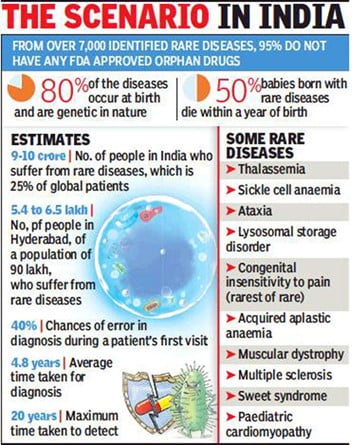
- Rare diseases are conditions with a low prevalence, affecting a small population.
- According to WHO, a disease is considered rare if it affects 1 or fewer in 1,000 people.
- They include genetic diseases, rare cancers, tropical diseases, and degenerative disorders.
- Global Scenario: Over 7,000 rare diseases exist, but only 5% are treatable.
- India’s Rare Disease Burden: India accounts for a significant portion of the global rare disease cases, with estimates suggesting that between 80 to 100 million people are affected.
- About 75% of those are children, and many of these diseases are life-threatening, contributing to high child mortality rates.
Challenges Posed by Rare Diseases
- Limited Access to Care: Lack of specialist availability hinder access, resulting in care disparities.
- Diagnostic Delays: Many rare diseases are poorly understood, leading to long diagnostic odysseys, misdiagnoses, and prolonged suffering.
- Treatment Issues: Limited research yields few approved treatments; healthcare professionals may lack experience or knowledge in managing these diseases.
- Financial Burden: High costs of treatment and care can lead to financial hardship for families and strain national healthcare systems.
- Psychosocial Impact: Patients and families face stress, anxiety, and social isolation, significantly affecting mental health.
- Education and Awareness: Lack of public understanding leads to misconceptions and stigma; increased awareness is essential for support and early diagnosis.
- Research and Innovation: Small patient populations and limited funding hinder research; collaboration among stakeholders is crucial for advancing therapies and outcomes.
National Policy for Rare Diseases (NPRD), 2021
- Aim: To reduce the prevalence and incidence of rare diseases in India.
- It categorises rare diseases into three groups based on treatment needs:
- Group 1: Disorders that can be treated with a one-time curative treatment.
- Group 2: Diseases requiring long-term or lifelong treatment but with lower treatment costs.
- Group 3: Diseases that have a definitive treatment, but patient selection is difficult, and costs are high.
- Centres of Excellence (CoEs): These are identified health facilities dedicated to diagnosing, preventing, and treating rare diseases. Eight such centres have been designated.
Financial Support:
- Up to ₹5 crore is provided to upgrade diagnostic facilities at CoEs.
- Patients suffering from rare diseases can receive up to ₹50 lakh for treatment at CoEs, separate from the Rashtriya Arogya Nidhi (RAN) scheme, which offers a maximum of ₹20 lakh.
- National Registry: A hospital-based national registry is being developed to collect data and support research into rare diseases
National Rare Disease Cases Committee
- It is a five-member panel to implement the rare diseases policy.
- Members: Experts from relevant fields, including medical professionals, policymakers, and representatives from healthcare institutions.
This committee is responsible for:
- Assessing individual cases to determine treatment needs.
- Implementing policy provisions through guidelines and strategies.
- Facilitating coordination among medical experts, policymakers, and healthcare institutions to address the challenges related to rare diseases.
- Monthly meeting, faster approval, and better Utilisation of Fund.
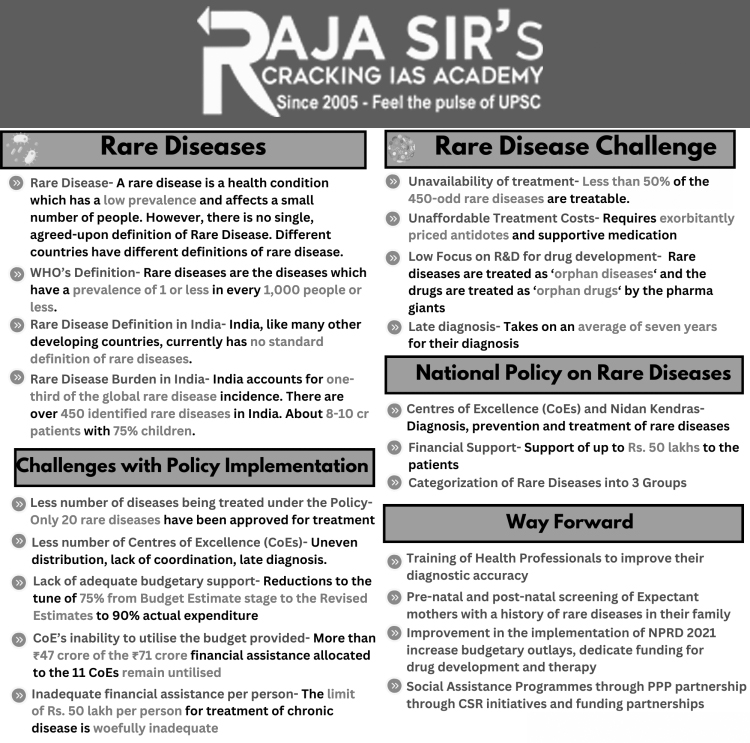
|
|
Central Electricity Regulatory Commission
The Central Electricity Regulatory Commission (CERC), appointed a single-member bench to assess the preparedness of stakeholders in handling sudden surges in power demand.
Central Electricity Regulatory Commission (CERC)
- Statutory body: Established under the Electricity Regulatory Commissions Act, 1998 by the Government of India.
- Composition: Comprises a Chairperson and four other members, including the Chairperson of the Central Electricity Authority as an ex-officio member.
Role:
- Promote competition, efficiency, and economy in bulk power markets.
- Improve the quality of power supply and encourage investments.
- Advise the government on removing institutional barriers to bridge the demand-supply gap, benefiting consumers.
- Regulator: CERC acts as the regulator for India’s power sector.
Electricity Act 2003
- A central law governing India’s electricity sector.
- Establishes Electricity Regulatory Commissions at both central (CERC) and state levels (SERCs).
|
|
Halari donkeys are considered to be intelligent animals which work closely with human beings.
Halari donkeys are endangered, with a population of fewer than 500.
- Origin: Native to the Halar region of Gujarat, India, particularly in the Jamnagar and Dwarka districts.
- Physical characteristics:
- They are white with black muzzles and hooves.
- They have a strong build and are large in size
- Appearance: Typically white, larger, and more resilient than other donkey breeds.
- Social behaviour: Form close bonds with humans and often work closely with their owners.
- Milk: Its milk is known for its sweetness and high lactose content.
- It is used to make milk powder and cosmetic products.
- The milk powder can fetch high value in the international market.
- Conservation: The National Bureau of Animal Genetic Resources and the Sahjeevan Trust are involved in the breeding and conservation of Halari donkeys.
IUCN Status: Endangered.
- Demand: There is demand from other parts of the country to set up Halari donkey dairies.
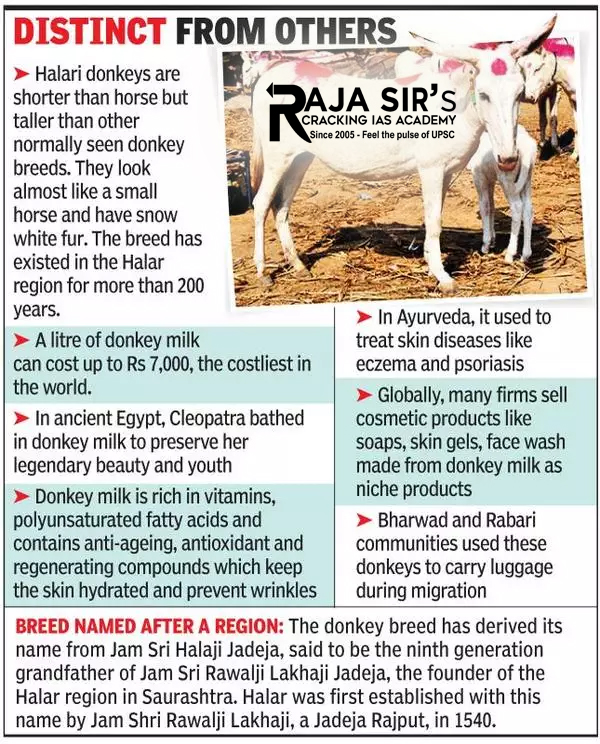
|
|
Passive Mutual Fund
Securities and Exchange Board of India (SEBI) introduced the liberalised Mutual Funds Lite (MF Lite) framework for passively managed schemes.
- About Mutual Funds Lite (MF Lite)
- It presents diversified investment opportunities for retail investors through less risky schemes and enhance market.
- Easier Entry for New Players: It lowers entry barriers, allowing more companies to offer passive mutual funds by relaxing net worth, profitability, and track record requirements.
- Simplified Role for Trustees: SEBI reduces oversight for trustees managing passive funds, lowering compliance costs due to the simpler nature of passively managed schemes.
- Faster Approval Process: It streamlines the approval process, cutting down on paperwork, enabling companies to launch funds faster.
- Options for Existing AMCs: Existing companies can either manage passive funds under MF Lite or continue with their current setup, benefiting from regulatory flexibility.
- Impact on Investors: Investors will gain access to more passive investment products, potentially improving returns, lowering costs, and boosting liquidity
Mutual Funds?
- A mutual fund is a pool of money managed by a professional Fund Manager. It is a trust that collects money from a number of investors who share a common investment objective and invests the same in equities, bonds, money market instruments and/or other securities.
- They are ideal for investors who either lack large sums for investment, or for those who neither have the inclination nor the time to research the market, yet want to grow their wealth.
Passive Mutual Fund
- Passive mutual funds are investment funds that aim to replicate the performance of a specific market index rather than trying to outperform it
- They usually track a benchmark index, say BSE Sensex or Nifty50, and try to mimic their performance.
- Actively managed funds: Fund managers make buy-and-sell decisions based on market analysis and research
- Passive mutual funds :Follow a buy-and-hold strategy based on an index.
Pros and Cons of Passive MF:
|
Pros
|
Cons
|
- Easily tracked: Since the underlying constituents of the benchmark indices are publicly available, passively managed schemes can be easily tracked and therefore less risky.
|
- No Outperformance: Designed to match, not to beat, the market. It limits the potential for higher returns that active fund managers might achieve.
|
- Predictability: Since they follow an index, the returns of passive funds are predictable, reflecting the overall market or sector they track.
|
- Lack of Flexibility: Must stick to their index even during market downturns, which may expose investors to losses.
|
|
|
10th Wild Ass Population Estimation (WAPE).
Key Findings:
The population of wild asses in Gujarat was estimated at 7,672 as per the 10th Wild Ass Population Estimation (WAPE).
- This marks a 26.14% increase from the 6,082 recorded in the 2020 estimation.
- Surendranagar district had the highest number of wild asses at 2,705, followed by Kutch (1,993), Patan (1,615), Banaskantha (710), Morbi (642), and Ahmedabad (7).
Indian Wild Asses:
- A subspecies of the Asian Wild Ass, known scientifically as Equus hemionus khur.
- Identified by distinctive white markings on the anterior part of the rump, posterior part of the shoulder, and a stripe down the back bordered by white.
- Distribution: The world’s last population of Indian Wild Asses is restricted to the Rann of Kachchh in Gujarat, India.
- Habitat: Inhabit desert and grassland ecosystems
Conservation Status:
- IUCN: Listed as Near Threatened.
- CITES: Listed under Appendix II.
- Wildlife Protection Act (1972): Classified under Schedule-I.
- Worldwide Species: There are three species of wild ass:
- One in Africa: Equus africanus
- Two in Asia: Equus hemionus and E. kiangs.
Wild Ass Sanctuary:
- Located in the Little Rann of Kutch, Gujarat.
- The only place where the Indian Wild Ass, locally called Khacchar, is found.
- The sanctuary is home to Rabari and Bharwad tribes.
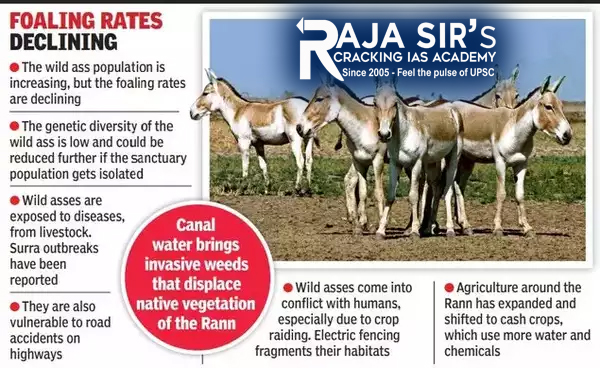
- Topology:
- It can be considered a large ecotone, a transitional area between marine and terrestrial ecosystems.
- It is a continuum of a dry area of dark silt with salt encrustation.
- It is dotted with about 74 elevated plateaus or islands, locally called 'bets'.
- During the monsoon, large parts are flooded to depths of up to 2m.
- Flora:
- It is full of dry thorny scrub, and there are no large trees except on the fringes and bets.
- Some of the plants and trees that are found in this sanctuary are Morad, Unt morad, Theg, Dolari, Khijdo, Kerdo, Mithi jar, Kheri pilu, Akado, etc.
- Fauna:
- Besides Indian Wild Ass, the other mammals found here include Blackbuck, Nilgai, Bluebull, Hare, Wolf, Foxes, Desert Cat, Indian fox, Jackal, Hyena, Wild boar, etc.
- There is rich birdlife, including the Houbara bustard, Sandgrouse, Pale harrier, Black-shouldered kite, Pelican, etc.
|
|
PSLV-37 mission re-enters Earth’s atmosphere
The Indian Space Research Organisation (ISRO) informed that the upper stage of the Polar Satellite Launch Vehicle C-37 (PSLV C-37 mission) re-entered the Earth’s atmosphere on October 6.
PSLV-C37 Mission
- Launched on February 15, 2017 with Cartosat-2D as the main payload along with another 103 satellites,
- INS-1A, INS- 1B, Al-Farabi 1, BGUSAT, DIDO-2, Nayif 1, PEASS, 88 Flock-3p satellites, and 8 Lemur-2 satellites.
Orbital Decay and Re-entry
- After injecting satellites into orbit, the PS4 upper stage was left in a 470×494 km orbit.
- Due to atmospheric drag, the orbit decayed, leading to re-entry.
- Re-entry occurred in the North Atlantic Ocean, as predicted by both ISRO and US Space Command (USSPACECOM).
Compliance with International Guidelines
- The re-entry was compliant with the Inter-Agency Space Debris Coordination Committee (IADC) guidelines, which recommend limiting post-mission orbital life of defunct objects in Low-Earth Orbit (LEO) to 25 years.
- ISRO reduced the residual orbital lifetime to 8 years through a passivation sequence.
Future Debris Mitigation Initiatives
- ISRO is working to reduce the post-mission orbital lifetime of PSLV upper stages to less than 5 years using engine restarts.
- Controlled re-entry is planned for future PSLV missions.
- ISRO aims to achieve the “Debris Free Space Mission” (DFSM) by 2030 as part of its commitment to space sustainability.
-
Debris-Free Space Missions (DFSM)
- The Debris-Free Space Missions (DFSM) is an initiative by the Indian Space Research Organisation (ISRO) to make all Indian space missions debris-free by 2030.
- The initiative aims to ensure the sustainability of space by reducing the amount of space debris and preventing future collisions.
- The DFSM initiative includes:
- Avoiding debris generation: This includes avoiding debris during the operational life of satellites and launch vehicles, as well as during post-mission disposal.
- Avoiding on-orbit collisions: This includes using failure mode studies, redundant systems, and mission design with high reliability.
Guidelines for space actors:
This includes for all Indian space actors, both governmental and non-governmental, It is on how to select clean orbits, budget fuel for post-mission disposals, and control trajectories during atmospheric re-entry.
|









 Latest News
Latest News






 General Studies
General Studies